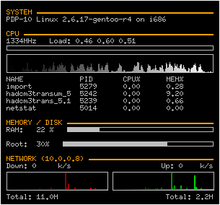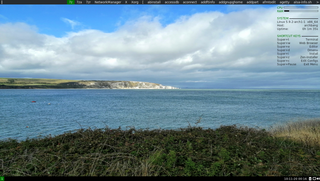 A typical Conky appearance | |
| Original author(s) | Brenden Matthews |
|---|---|
| Stable release | |
| Repository | |
| Written in | C, C++ |
| Operating system | Linux, FreeBSD, and OpenBSD |
| Type | System monitor |
| License | GPL and BSD licenses [2] |
| Website | github |
Conky is a free software desktop system monitor for the X Window System. It is available for Linux, FreeBSD, and OpenBSD. [3] Conky is highly configurable [4] [5] [6] and is able to monitor many system variables including the status of the CPU, memory, swap space, disk storage, temperatures, processes, network interfaces, battery power, system messages, e-mail inboxes, Arch Linux updates, many popular music players (MPD, XMMS2, BMPx, Audacious, etc.), weather updates, breaking news, and much more. [7] Unlike system monitors that use high-level widget toolkits to render their information, Conky is drawn directly in an X window. This allows it to be configured such that it consumes relatively few system resources. [8]
Contents
Conky was hailed as "one of the best maintained, and definitely one of the most useful, programs in the world of open source" in Linux Magazine . [9]
It comes pre-configured in the default installation of Pinguy OS and CrunchBang Linux. [10] [11]



















